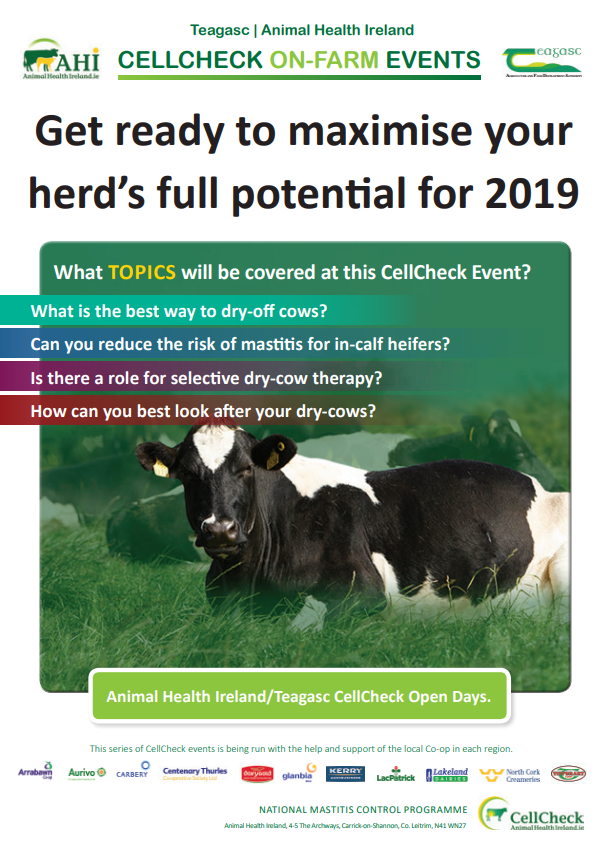According to AHI, one important aspect of the dry period is Dry-Cow Therapy (DCT). This is the treatment of cows at the end of lactation with a long acting antibiotic and/or an internal teat sealer. Using DCT is one of the components of an effective mastitis control programme.
The purpose of DCT is to:
• Treat any intra-mammary infections;
• Protect against new infections during the dry period.
The DCT product used on your farm will depend on what bacterial challenges you have had during the year and a discussion with your veterinary practitioner is key when deciding what product to use.
The steps taken by farmers when drying-off cows can have a significant impact on mastitis levels during the dry period and also during the following lactation. It’s critical that the procedure is carried out correctly. It is also essential that farmers prepare by allowing adequate time and labour when administering dry-cow products to their herd and that staff are adequately trained.
[smartslider3 slider=24]
- Wear milking apron/parlour suit and nitrile disposable gloves.
- Identify the cow and clearly mark with an ankle strap, tail tape or marker.
- Milk out the cow completely.
- Ensure that teats are clean and dry.
- Completely disinfect the teat ends thoroughly with cotton wool and methylated/surgical spirits by vigorously rubbing the teat end opening for a minimum of 10 seconds. This step is critical.
- Disinfect the teats furthest away first followed by the teats nearest to you to prevent re-contamination.
- Check the teat wipe – if there is a dirty colour, repeat the scrub using a new cotton ball until it is clear.
- Treat the teats nearest you first followed by the more distant teats to prevent recontaminating the teats.
- Keep the nozzle of the tube sterile to prevent introducing new infections into the teats and udder.
- Insert the tip of the nozzle into the teat opening and squeeze the contents gently into the quarter – it is not necessary or recommended to insert the tube nozzle to its full depth as this may damage the teat end.
- When the tube is emptied into the teat, massage the antibiotic up into the quarter.
- Thoroughly spray or dip the teats with teat disinfectant after treatment.
- Record the antibiotic used.
- Make note of the following:
• Cow number;
• Date;
• Product used;
• Withholding period.
If teat sealer is being used in addition to the antibiotic, follow the same protocol as above except the teat sealer is not massaged into the quarter. Before squeezing the contents of the tube of sealer into the teat, use your free hand to close off the base of the teat, where it joins the udder. The teat sealer is then left in the teat. This acts as a physical barrier to bacterial infection of the cows teats and provides extra protection towards the end of the dry period and especially around calving time. The biggest risks of infection during the dry-cow period are at the beginning and the end of the dry-cow period.
General points around drying off
- Ensure cows’ tails are clipped prior to drying-off.
- Dry-off cows as soon as their production reaches 9 litres per day.
- The use of a head flash lamp can increase the visibility when drying-off cows.
- Dry-off cows abruptly – do not skip days and preferably do not skip milkings.
- Keep the number of cows to be treated to a manageable number i.e. 20 per person per
day if using antibiotic only and 10 per person per day if using antibiotic and teat sealer. - If using teat sealer only on a portion of the herd, dry these off in a separate batch from
cows getting antibiotic or antibiotics and teat sealer. - Ensure cows remain standing for the first 2 hours after DCT so as to allow sufficient time
for the teat canal to close. - Ideally, cows that have been treated with DCT should be kept away from the sound of the
milking machine to avoid the stimulus to let milk down. - Put cows in clean areas after treatment and maintain a clean environment during the
dry-cow period to avoid picking up new infections. - Do not use antibiotic DCT on cows that are going to be culled within the next 2-3 months
to avoid unacceptable meat residues. - Don’t use DCT on quarters that were dried off during the previous lactation.
- Observe cows on a daily basis during the dry-cow period for signs of mastitis.
- Check each cow that received antibiotic DCT has passed her minimum dry period when
she calves, and withhold milk from the bulk tank for the period specified by the product. - Withhold milk from all cows from the bulk tank for at least 8 milkings after calving to
ensure that no colostrum or transition milk goes into the tank. This also prevents teat
seal residues from entering the bulk tank.
You can now record what treatment is being used at dry-off. Users now have the option to record ‘Dry Cow Tube’, ‘Dry Tube and Sealer’, ‘Teat Sealer Only’ or ‘No Treatment’. This record events profile is now also available to use on the ICBF Web Application.
Content Source: – www.animalhealthireland.ie

